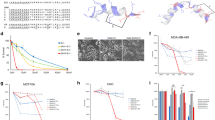Abstract
The human epidermal growth factor receptor 2 (EGFR2 or HER2) has been established as a therapeutic target for HER2-positive breast cancer. Although a number of small-molecule agents have been developed to target HER2, many adverse drug reactions (ADRs) such as side effects and drug resistance are frequently observed in the chemotherapeutics. Previously, peptides derived from MIG6 protein, a natural negative regulator of EGFR and HER2, have been shown to destabilize EGFR dimerization (Zhang et al. 2007). Here, we grafted a MIG6 fragment (336KSLPSYLNGVMPPTQSFAPDPKYVSS361) in crystal interaction site from EGFR to HER2, truncated the fragment to obtain a short segment (346MPPTQSFA353) with reserved binding capability (K d = 121.6 ± 14.5 μM) to HER2 kinase domain, and optimized the segment to improve its affinity for the domain. Consequently, three peptides (MLPNQSFA, MFPNQSFA and MFPYQSFA) were successfully designed to exhibit moderate or high potency (K d = 78.0 ± 9.8, 28.7 ± 3.9 and 65.1 ± 7.2 μM, respectively) towards HER2 kinase domain, which are expected to destabilize HER2 dimerization and then suppress the kinase activation in breast cancer.







Similar content being viewed by others
References
Ahsan A, Ray D, Ramanand SG, Hegde A, Whitehead C, Rehemtulla A, Morishima Y, Pratt WB, Osawa Y, Lawrence TS, Nyati MK (2013) Destabilization of the epidermal growth factor receptor (EGFR) by a peptide that inhibits EGFR binding to heat shock protein 90 and receptor dimerization. J Biol Chem 288:26879–26886
Babar T, Blomberg C, Hoffner E, Yan X (2014) Anti-HER2 cancer therapy and cardiotoxicity. Curr Pharm Des 20:4911–4919
Berman HM, Westbrook J, Feng Z, Gilliland G, Bhat TN, Weissig H, Shindyalov IN, Bourne PE (2000) The protein data bank. Nucleic Acids Res 28:235–242
Bose R, Kavuri SM, Searleman AC, Shen W, Shen D, Koboldt DC, Monsey J, Goel N, Aronson AB, Li S, Ma CX, Ding L, Mardis ER, Ellis MJ (2013) Activating HER2 mutations in HER2 gene amplification negative breast cancer. Cancer Discov 3:224–337
Brown NP, Leroy C, Sander C (1998) MView: a web-compatible database search or multiple alignment viewer. Bioinformatics 14:380–381
Case DA, Cheatham TE, Darden T, Gohlke H, Luo R, Merz KM Jr, Onufriev A, Simmerling C, Wang B, Woods RJ (2005) The Amber biomolecular simulation programs. J Comput Chem 26:1668–1688
Darden T, York D, Pedersen L (1993) Particle mesh Ewald: an N.log(N) method for Ewald sums in large systems. Chem Phys 98:10089–10092
Duan Y, Wu C, Chowdhury S, Lee MC, Xiong G, Zhang W, Yang R, Cieplak P, Luo R, Lee T, Caldwell J, Wang J, Kollman P (2003) A point-charge force field for molecular mechanics simulations of proteins based on condensed-phase quantum mechanical calculations. J Comput Chem 24:1999–2012
Fiorentino L, Pertica C, Fiorini M, Talora C, Crescenzi M, Castellani L, Alemà S, Benedetti P, Segatto O (2000) Inhibition of ErbB-2 mitogenic and transforming activity by RALT, a mitogeninduced signal transducer which binds to the ErbB-2 kinase domain. Mol Cell Biol 20:7735–7750
Fosgerau K, Hoffmann T (2015) Peptide therapeutics: current status and future directions. Drug Discov Today 20:122–128
Hackel PO, Gishizky M, Ullrich A (2001) Mig-6 is a negative regulator of the epidermal growth factor receptor signal. Biol Chem 382:1649–1662
Homeyer N, Gohlke H (2012) Free energy calculations by the molecular mechanics Poisson-Boltzmann surface area method. Mol Inf 31:114–122
Jorgensen WL, Chandrasekhar J, Madura JD, Impey RW, Klein ML (1983) Comparison of simple potential functions for simulating liquid water. J Chem Phys 79:926–935
Kortemme T, Kim DE, Baker D (2004) Computational alanine scanning of protein-protein interfaces. Sci STKE 2004 219:l2
Liu HM, Li LJ, Guo J, Yang ZJ, Yang X, Qi RP, Cao W (2014) Evolution of high-affinity peptide probes to detect the SH3 domain of cancer biomarker BCR-ABL. Int J Pept Res Ther 20:201–208
Park E, Kim N, Ficarro SB, Zhang Y, Lee BI, Cho A, Kim K, Park AK, Park WY, Murray B, Meyerson M, Beroukhim R, Marto JA, Cho J, Eck MJ (2015) Structure and mechanism of activity-based inhibition of the EGF receptor by Mig6. Nat Struct Mol Biol 22:703–711
Ryckaert JP, Ciccotti G, Berendsen HJC (1977) Numerical integration of the Cartesian equations of motion of a system with constraints: molecular dynamics of n-alkanes. J Comput Phys 23:327–341
Schlessinger J (2002) Ligand-induced, receptor-mediated dimerization and activation of EGF receptor. Cell 110:669–672
Spector N, Xia W, El-Hariry I, Yarden Y, Bacus S (2007) HER2 therapy. Small molecule HER-2 tyrosine kinase inhibitors. Breast Cancer Res 9:205
Vriend G (1990) WHAT IF: a molecular modeling and drug design program. J Mol Graph 8:52–56
Wallace AC, Laskowski RA, Thornton JM (1996) LIGPLOT: a program to generate schematic diagrams of protein-ligand interactions. Protein Eng 8:127–134
Yarden Y (2001) Biology of HER2 and its importance in breast cancer. Oncology 61:1–13
Zhang X, Pickin KA, Bose R, Jura N, Cole PA, Kuriyan J (2007) Inhibition of the EGF receptor by binding of MIG6 to an activating kinase domain interface. Nature 450:741–744
Acknowledgments
This work was supported by the Foundations of Taizhou Municipal Hospital.
Author information
Authors and Affiliations
Corresponding authors
Ethics declarations
Conflict of interest
None.
Rights and permissions
About this article
Cite this article
Yu, XD., Guo, AF., Zheng, GH. et al. Design and Optimization of Peptide Ligands to Target Breast Cancer-Positive HER2 by Grafting and Truncation of MIG6 Peptide. Int J Pept Res Ther 22, 229–236 (2016). https://doi.org/10.1007/s10989-015-9501-9
Accepted:
Published:
Issue Date:
DOI: https://doi.org/10.1007/s10989-015-9501-9




